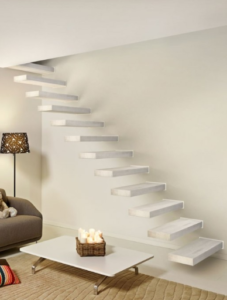Stairs are a common feature in many homes, providing access to different levels and adding architectural interest to interior spaces. However, without proper safety precautions, stairs can pose a risk of accidents and injuries, especially for young children, elderly individuals, and people with mobility issues.
Implementing effective stair safety measures is essential for homeowners to ensure the well-being of their families and guests. In this guide, we’ll explore 7 important stair safety tips that homeowners can follow to create a safer environment in their homes.
1. Keep Stairs Clear of Clutter:
It’s not uncommon for stairs to accumulate clutter, from shoes and bags to toys and books. However, these seemingly innocuous items can quickly turn into tripping hazards, posing a danger to anyone navigating the staircase. A toy left on the step or a shoe placed haphazardly can cause a dangerous fall, leading to injuries.
Encouraging everyone in the household to pick up after themselves and store items in designated areas can significantly reduce the risk of accidents. Regular inspections of the stairs and landing areas should become a part of your routine to ensure they remain clutter-free, creating a safer environment for everyone in your household. This simple practice can go a long way in enhancing overall stair safety and preventing potentially serious accidents.
2. Install Secure Handrails:
Handrails play a crucial role in providing support and stability, particularly for individuals with limited mobility or balance issues. It’s essential to ensure that handrails are securely installed on both sides of the staircase and are at a comfortable height for all users.
Periodically checking for loose or wobbly handrails is vital, as any instability can increase the risk of falls. Prompt repairs should be made to any issues identified to prevent accidents and maintain the safety of the stairway, providing peace of mind for everyone who uses them.
3. Adequate Lighting:
Proper lighting is indispensable for navigating stairs safely, especially in low-light conditions where visibility may be compromised. Installing bright overhead lights or motion-sensor lighting near the stairs ensures good visibility, reducing the likelihood of missteps or falls. 
Consider adding lighting along the staircase wall or on each step for additional illumination, particularly in areas where natural light is insufficient. Regularly replacing burnt-out bulbs is crucial to maintaining adequate lighting levels and ensuring safe passage on the stairs, minimizing the risk of accidents, and promoting a safer environment for all occupants.
4. Use Anti-Slip StairTreads:
Slippery stairs pose a significant hazard, particularly in wet or icy conditions. Plus, even in dry conditions, smooth surfaces can still be slippery for individuals wearing socks or smooth-soled shoes. Protect yourself with Anti Slip Stair Treads designed to provide enhanced grip and stability. These treads provide an extra layer of safety by offering traction and grip, reducing the risk of slips and falls, especially on outdoor stairs exposed to the elements.
Made from durable materials like rubber, vinyl, or abrasive grit coatings, anti-slip stair treads are designed to withstand heavy foot traffic while enhancing stability. By investing in anti-slip stair treads, you create a safer environment for everyone using the stairs, regardless of weather conditions or footwear. Don’t wait for an accident to happen; take proactive measures to prevent falls and injuries with anti-slip stair treads.
5. Repair Loose or Damaged Steps:
Regular inspection of stairs is essential to identify any signs of wear and tear, such as loose threads, cracked steps, or damaged handrails. Addressing these issues promptly by repairing or replacing damaged components is important to preventing accidents and ensuring the structural integrity of the staircase.
Hiring a professional contractor may be necessary for more extensive repairs to guarantee the safety of the stairs for all occupants. By maintaining the integrity of the staircase, you create a safer environment and reduce the risk of accidents, promoting peace of mind for everyone in your household.
6. Teach Safe Stair Habits:
Educating family members, especially children, about safe stair habits is paramount  in preventing accidents. Teaching children to use handrails, hold onto them while ascending or descending, and avoid running or playing on the stairs can significantly reduce the risk of falls.
in preventing accidents. Teaching children to use handrails, hold onto them while ascending or descending, and avoid running or playing on the stairs can significantly reduce the risk of falls.
Encouraging everyone to use caution and take one step at a time, particularly when carrying bulky items or wearing slippery footwear, reinforces safe stair practices and promotes a culture of safety within the household. By instilling these habits, you empower your family members to navigate the stairs safely, reducing the likelihood of accidents and promoting overall household safety.
7. Install Baby Gates:
For households with young children or pets, installing safety gates at the top and bottom of the stairs is essential to prevent accidental falls. Choosing gates that are sturdy, securely mounted, and equipped with childproof latches ensures effective protection.
It’s crucial to follow manufacturer guidelines for proper installation and regularly check for any signs of wear or damage to maintain the integrity of the safety gates. These measures provide peace of mind for parents and caregivers, knowing that their little ones are protected from potential stair-related accidents. By installing baby gates, you create a physical barrier that prevents access to the stairs, reducing the risk of falls and ensuring the safety of your children and pets.
Conclusion
Prioritizing stair safety is essential for homeowners to prevent accidents and injuries within the home. By implementing these seven important stair safety tips, you can create a safer environment for everyone in your household to navigate stairs with confidence and peace of mind. Remember to keep stairs clear of clutter, install secure handrails, maintain adequate lighting, use non-slip stair treads, and conduct regular maintenance checks to ensure optimal safety at all times.
Note: This is a collaborative post

No Comments